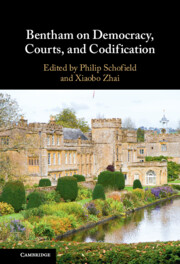Book contents
- Bentham on Democracy, Courts, and Codification
- Bentham on Democracy, Courts, and Codification
- Copyright page
- Contents
- Contributors
- Introduction
- Part I Democracy
- 1 Intellectual Aptitude and the General Interest in Bentham’s Democratic Thought
- 2 Bentham, Democracy, Free Government, and the Relationship between Rulers and Ruled
- 3 The Interests of Women in Bentham’s Late Constitutional Thought
- 4 Religion and Judgement in Bentham’s Political Thought
- 5 Organizing the Utilitarian State
- 6 Bentham on the Corruption of Democracy
- 7 The People’s ‘Greatest Misfortune’ and ‘All the Chance the People Have’
- Part II Law and the Courts
- Part III Codification
- Bibliography
- Index
7 - The People’s ‘Greatest Misfortune’ and ‘All the Chance the People Have’
Bentham on the Separation of Powers
from Part I - Democracy
Published online by Cambridge University Press: 25 August 2022
- Bentham on Democracy, Courts, and Codification
- Bentham on Democracy, Courts, and Codification
- Copyright page
- Contents
- Contributors
- Introduction
- Part I Democracy
- 1 Intellectual Aptitude and the General Interest in Bentham’s Democratic Thought
- 2 Bentham, Democracy, Free Government, and the Relationship between Rulers and Ruled
- 3 The Interests of Women in Bentham’s Late Constitutional Thought
- 4 Religion and Judgement in Bentham’s Political Thought
- 5 Organizing the Utilitarian State
- 6 Bentham on the Corruption of Democracy
- 7 The People’s ‘Greatest Misfortune’ and ‘All the Chance the People Have’
- Part II Law and the Courts
- Part III Codification
- Bibliography
- Index
Summary
A bill of rights and the separation of powers have widely been accepted as two basic safeguards of constitutional liberty.1 Bentham, however, denounces both notions as nonsense. His criticism of the discourse of entrenched and inalienable rights is well-known and has been fully discussed.2 In contrast, his discussion of the principle of the separation of powers has not been as fully treated as it deserves. The conventional view is that Bentham in his constitutional design rejects the separation of powers and advocates instead the principle of the dependence of the governors on the governed and a supreme, omni-competent, and unicameral legislature.3 However, this view of Bentham’s position is imprecise and incomplete for at least two reasons. First, the phrase ‘the separation of powers’ was ambiguous. Bentham accepts the separation of powers in some forms and rejects it in others. Second, Bentham’s rejection of the separation of powers in certain forms is conditional, not outright: he admits that it might be useful and necessary in real politics.4
- Type
- Chapter
- Information
- Bentham on Democracy, Courts, and Codification , pp. 157 - 192Publisher: Cambridge University PressPrint publication year: 2022

